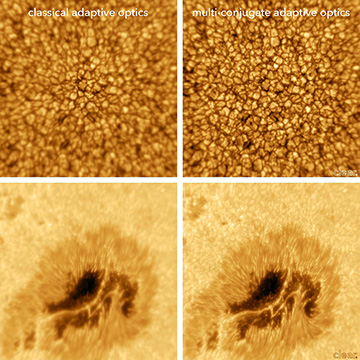
Images of solar-surface granulation (top) and a single sunspot (bottom) from the 1.6-m New Solar Telescope at the Big Bear Solar Observatory, Calif., USA. The images on the left used classical, one-mirror adaptive optics (AO); the images on the right used the three-mirror, multiconjugate AO approach that corrects for turbulence at multiple points in the atmosphere along the scope’s line of sight. The images show an area approximately 37,000 km2 on the solar surface. [Image: Big Bear Solar Observatory] [Enlarge image]
Adaptive-optics (AO) systems, which use a deformable mirror and computer processing to compensate for turbulence in the Earth’s atmosphere, have revolutionized the study of distant stars from ground-based telescopes. But imaging the detailed activity of a much closer object—the sun—requires a clear image over a wider field of view than classical AO can provide.
Scientists in the United States, Germany and Australia have now used a “multiconjugate” AO (MCAO) system that combines three deformable mirrors to considerably widen the field of view. And, using the setup, the team has been able to create sharp, detailed images of phenomena tens of thousands of kilometers across on the solar surface (Astron. Astophys., doi: 10.1051/0004-6361/201629970).
Coping with variable turbulence
Classical AO uses a single deformable mirror, in a position optically conjugate to the telescope pupil, to iteratively correct images for atmospheric turbulence through wavefront shaping. Atmospheric turbulence isn’t homogeneous, however. In particular, it can vary strongly with altitude.
In practical terms, that means that, for classical AO systems, the validity of the wavefront correction, and hence the image quality, falls off rapidly outside of a limited viewing angle, the so-called isoplanatic angle. Within the visible-light wavelength band, that isoplanatic angle is commonly only around 5 to 15 seconds of arc—too narrow for a diffraction-limited view of large-scale solar phenomena, such as sunspots and the solar storms, flares and prominences that can cause “space weather” and disrupt communications on Earth.
A three-mirror solution
To widen the correctable field of view, a number of research teams have experimented in recent years with MCAO systems, which combine multiple deformable mirrors to sample and correct for turbulence-induced optical aberrations at different points in the atmosphere, and then computationally combine the images. Until now, however, gains from MCAO hadn’t been demonstrated in actual solar observations.
In the current work, led by scientists from the National Solar Observatory and the Big Bear Solar Observatory, USA, the team installed a three-mirror MCAO system, dubbed Clear, on the 1.6-m New Solar Telescope at Big Bear, Calif., currently the world’s highest-resolution solar telescope. Each of the three deformable mirrors is controlled by 357 separate actuators. One of the mirrors is positioned to be optically conjugate to the telescope pupil, as in classical AO; the other two are positioned to be conjugate with points roughly 3 km and 8 km away from the telescope on the line of sight.
Tripling the field of view
In a ten-day observational run last July, the research team put the new setup at Big Bear through its paces. The researchers used a high-speed camera to capture successive, iterative images while the AO system was working, and to compare, in real time, the results of MCAO and classical AO.
The researchers found that the system substantially cleared up the picture across a field of view spanning 53 seconds of arc—more than three times the usable field of view in a classical AO scheme—in images of solar granulation and sunspot activity. At solar distances, that equates to the ability to capture detailed images of phenomena stretching nearly 37,000 km across the solar surface.
According to the scientists, the experiments at Big Bear constituted a useful proving ground for MCAO that lays the groundwork for similar systems at a range of other solar telescopes. In particular, the upcoming Daniel K. Inouye Solar Telescope, a 4-m facility in Hawaii slated to go into operation in 2020, will likely incorporate MCAO, in part based on the successful application of the technology at Big Bear. The result could be some dramatic new insights on what’s going on at the solar surface.
In addition to scientists at the NSO and Big Bear observatories, researchers from the Kiepenheuer-Institut fur Sonnenphysik (Germany), the Large Binocular Telescope Array (USA), and the Australian National University also contributed to the work.
